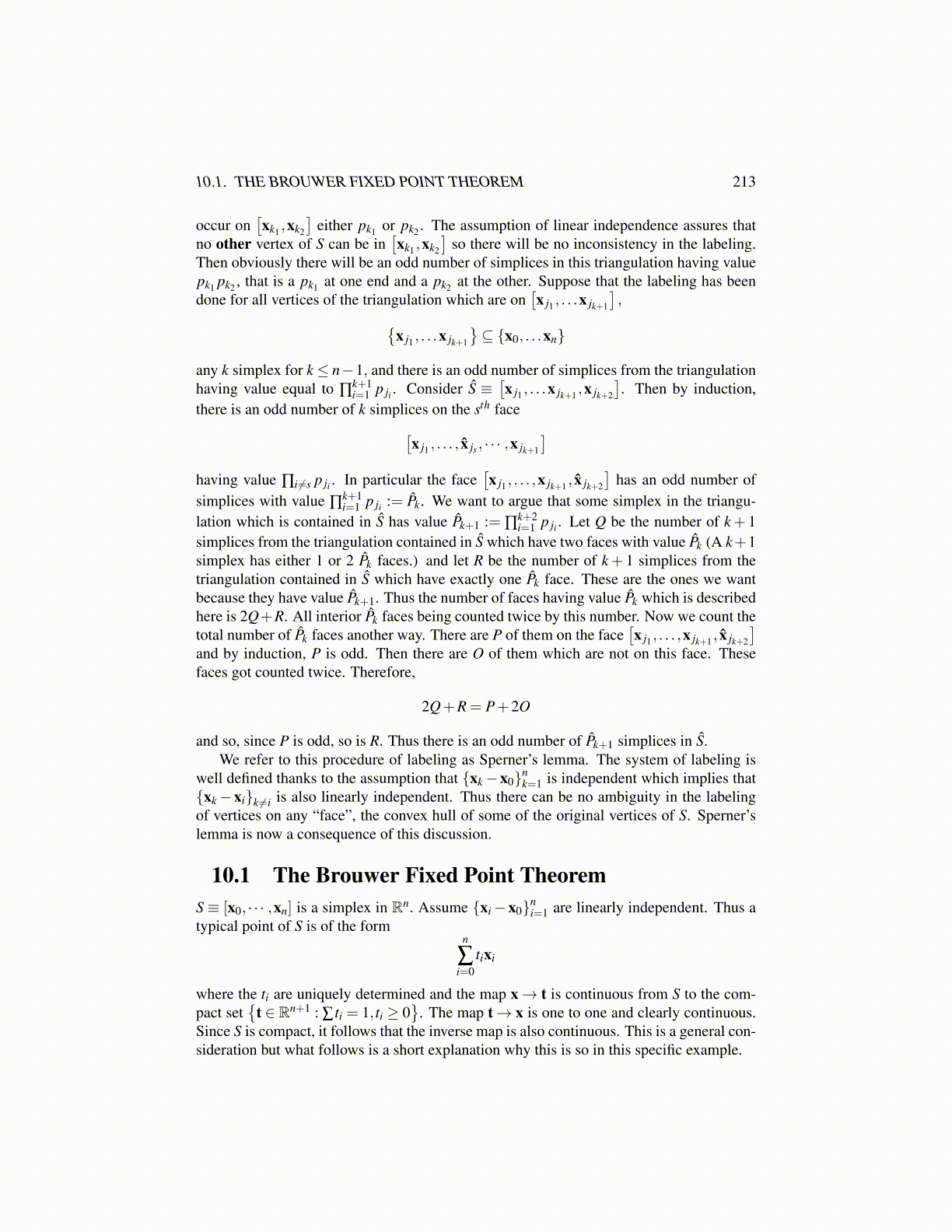
10.1. THE BROUWER FIXED POINT THEOREM 213
occur on[xk1 ,xk2
]either pk1 or pk2 . The assumption of linear independence assures that
no other vertex of S can be in[xk1 ,xk2
]so there will be no inconsistency in the labeling.
Then obviously there will be an odd number of simplices in this triangulation having valuepk1 pk2 , that is a pk1 at one end and a pk2 at the other. Suppose that the labeling has beendone for all vertices of the triangulation which are on
[x j1 , . . .x jk+1
],{
x j1 , . . .x jk+1
}⊆ {x0, . . .xn}
any k simplex for k≤ n−1, and there is an odd number of simplices from the triangulationhaving value equal to ∏
k+1i=1 p ji . Consider Ŝ ≡
[x j1 , . . .x jk+1 ,x jk+2
]. Then by induction,
there is an odd number of k simplices on the sth face[x j1 , . . . , x̂ js , · · · ,x jk+1
]having value ∏i̸=s p ji . In particular the face
[x j1 , . . . ,x jk+1 , x̂ jk+2
]has an odd number of
simplices with value ∏k+1i=1 p ji := P̂k. We want to argue that some simplex in the triangu-
lation which is contained in Ŝ has value P̂k+1 := ∏k+2i=1 p ji . Let Q be the number of k+ 1
simplices from the triangulation contained in Ŝ which have two faces with value P̂k (A k+1simplex has either 1 or 2 P̂k faces.) and let R be the number of k+ 1 simplices from thetriangulation contained in Ŝ which have exactly one P̂k face. These are the ones we wantbecause they have value P̂k+1. Thus the number of faces having value P̂k which is describedhere is 2Q+R. All interior P̂k faces being counted twice by this number. Now we count thetotal number of P̂k faces another way. There are P of them on the face
[x j1 , . . . ,x jk+1 , x̂ jk+2
]and by induction, P is odd. Then there are O of them which are not on this face. Thesefaces got counted twice. Therefore,
2Q+R = P+2O
and so, since P is odd, so is R. Thus there is an odd number of P̂k+1 simplices in Ŝ.We refer to this procedure of labeling as Sperner’s lemma. The system of labeling is
well defined thanks to the assumption that {xk−x0}nk=1 is independent which implies that
{xk−xi}k ̸=i is also linearly independent. Thus there can be no ambiguity in the labelingof vertices on any “face”, the convex hull of some of the original vertices of S. Sperner’slemma is now a consequence of this discussion.
10.1 The Brouwer Fixed Point TheoremS ≡ [x0, · · · ,xn] is a simplex in Rn. Assume {xi−x0}n
i=1 are linearly independent. Thus atypical point of S is of the form
n
∑i=0
tixi
where the ti are uniquely determined and the map x→ t is continuous from S to the com-pact set
{t ∈ Rn+1 : ∑ ti = 1, ti ≥ 0
}. The map t→ x is one to one and clearly continuous.
Since S is compact, it follows that the inverse map is also continuous. This is a general con-sideration but what follows is a short explanation why this is so in this specific example.